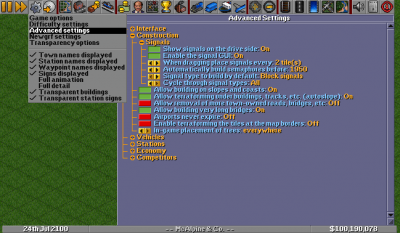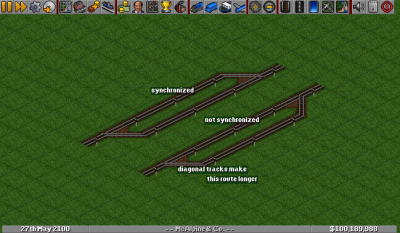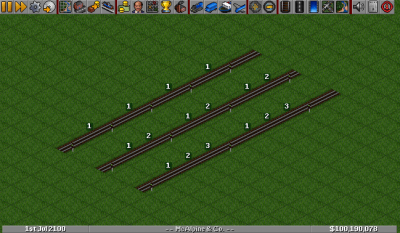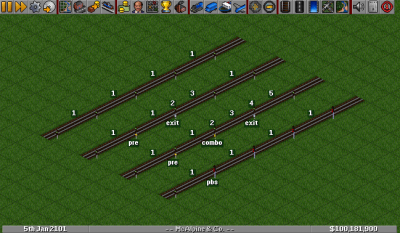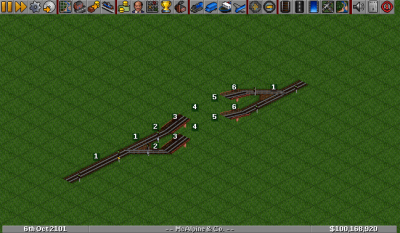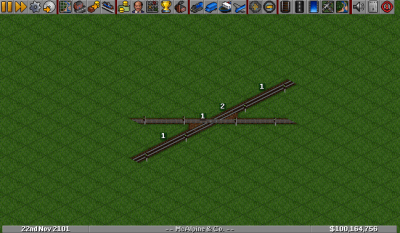Difference between revisions of "Signal gap"
From #openttdcoop wiki
m (Add screenshot request) |
m (Added screenshots, removed Reqscreenshot tag) |
||
| Line 1: | Line 1: | ||
| − | |||
== Definition == | == Definition == | ||
| + | [[Image:Signal gap settings.png | thumb | 400px | right | Configuring auto-signalling]] | ||
A signal gap, or gap for short, is the amount of unsignalled space in a single signal block. Understanding signal gaps is important for maximizing train density on a rail line and ensuring that trains continue to move at the maximum allowable speed. In coop games, we adhere to a maximum signal gap of 1 tile. | A signal gap, or gap for short, is the amount of unsignalled space in a single signal block. Understanding signal gaps is important for maximizing train density on a rail line and ensuring that trains continue to move at the maximum allowable speed. In coop games, we adhere to a maximum signal gap of 1 tile. | ||
| Line 7: | Line 7: | ||
Do not confuse a "signal gap" with a "train gap". A train gap is the minimum space between two trains. Because our signals are 2 spaced tiles apart (also known as [http://wiki.openttd.org/Railway_Designs Signal Density]), there is a minimum gap of 3 (the Signal Density +1). | Do not confuse a "signal gap" with a "train gap". A train gap is the minimum space between two trains. Because our signals are 2 spaced tiles apart (also known as [http://wiki.openttd.org/Railway_Designs Signal Density]), there is a minimum gap of 3 (the Signal Density +1). | ||
| + | <br clear=all> | ||
== Why is understanding gaps important? == | == Why is understanding gaps important? == | ||
A rail line is only as fast as its weakest link. If there is any point on the line where traffic must slow down or stop, the disruption will have a domino effect on any following trains, resulting in an inefficient network. As the goal is often to build a highly-efficient, and highly-dense network, these types of disruptions must be avoided at all costs! | A rail line is only as fast as its weakest link. If there is any point on the line where traffic must slow down or stop, the disruption will have a domino effect on any following trains, resulting in an inefficient network. As the goal is often to build a highly-efficient, and highly-dense network, these types of disruptions must be avoided at all costs! | ||
| + | <br clear=all> | ||
== What if I need to create a signal gap larger than 1? == | == What if I need to create a signal gap larger than 1? == | ||
| − | + | [[Image:Signal gap sync.png | thumb | 400px | right | Make sure alternate routes are in sync]] | |
To create a signal gap larger than 1, you must provide following trains an alternate route until the gap is restored to 1. Larger gaps are created at station platforms, bridges, and tunnels, since none of these items can be signalled. | To create a signal gap larger than 1, you must provide following trains an alternate route until the gap is restored to 1. Larger gaps are created at station platforms, bridges, and tunnels, since none of these items can be signalled. | ||
To create an alternate route, simply make a new line parallel to the first line. This line should continue until the signal gap can be restored to 1, making sure to keep the trains [[Line sync|synchronize]]d. | To create an alternate route, simply make a new line parallel to the first line. This line should continue until the signal gap can be restored to 1, making sure to keep the trains [[Line sync|synchronize]]d. | ||
| + | <br clear=all> | ||
== How to count the length of a gap == | == How to count the length of a gap == | ||
When using normal block signals, a gap's length is defined as the number of unsignalled spaces between two signals. Normal coop [[mainline]]s use a signal gap of 1, meaning there is only 1 unsignalled tiles between two signalled tiles. | When using normal block signals, a gap's length is defined as the number of unsignalled spaces between two signals. Normal coop [[mainline]]s use a signal gap of 1, meaning there is only 1 unsignalled tiles between two signalled tiles. | ||
| Line 25: | Line 28: | ||
When using PBS signals, the gap is counted just like normal block signals: from the tile after the PBS signal through (but not including) the next signalled tile. If multiple routes exist, the largest value is the gap. | When using PBS signals, the gap is counted just like normal block signals: from the tile after the PBS signal through (but not including) the next signalled tile. If multiple routes exist, the largest value is the gap. | ||
| + | [[Image:Signal gap counting.png | 400px | thumb | left | Counting signal gaps]] [[Image:Signal gap signals.png | 400px | thumb | left | Other signals]] | ||
| + | <br clear=all> | ||
== How many alternate routes do I need to create? == | == How many alternate routes do I need to create? == | ||
| − | + | [[Image:Signal gap bridges.png | thumb | 400px | right | Two bridges for this gap is enough for any train length]] | |
The number of alternate routes is dependent on the length of the gap and the minimum train length that might encounter the gap. | The number of alternate routes is dependent on the length of the gap and the minimum train length that might encounter the gap. | ||
| Line 46: | Line 51: | ||
Refer to the section above for information about how to count a gap properly. | Refer to the section above for information about how to count a gap properly. | ||
| + | <br clear=all> | ||
== The Evil X == | == The Evil X == | ||
| − | + | [[Image:Signal gap evilx.png | thumb | 400px | right | The Evil X]] | |
When two lines cross each other in an oblique (non-perpendicular) way, it creates an "evil X". The main problem with the evil X is that it inherently creates a signal gap of 2. | When two lines cross each other in an oblique (non-perpendicular) way, it creates an "evil X". The main problem with the evil X is that it inherently creates a signal gap of 2. | ||
Revision as of 14:57, 16 February 2010
Contents
Definition
A signal gap, or gap for short, is the amount of unsignalled space in a single signal block. Understanding signal gaps is important for maximizing train density on a rail line and ensuring that trains continue to move at the maximum allowable speed. In coop games, we adhere to a maximum signal gap of 1 tile.
In general, use of the term "gap" indicates that a signal gap of length greater than 1 has been detected, and as a result, the efficiency of the network is at risk. Steps should be taken to fix any gaps marked in this manner.
Do not confuse a "signal gap" with a "train gap". A train gap is the minimum space between two trains. Because our signals are 2 spaced tiles apart (also known as Signal Density), there is a minimum gap of 3 (the Signal Density +1).
Why is understanding gaps important?
A rail line is only as fast as its weakest link. If there is any point on the line where traffic must slow down or stop, the disruption will have a domino effect on any following trains, resulting in an inefficient network. As the goal is often to build a highly-efficient, and highly-dense network, these types of disruptions must be avoided at all costs!
What if I need to create a signal gap larger than 1?
To create a signal gap larger than 1, you must provide following trains an alternate route until the gap is restored to 1. Larger gaps are created at station platforms, bridges, and tunnels, since none of these items can be signalled.
To create an alternate route, simply make a new line parallel to the first line. This line should continue until the signal gap can be restored to 1, making sure to keep the trains synchronized.
How to count the length of a gap
When using normal block signals, a gap's length is defined as the number of unsignalled spaces between two signals. Normal coop mainlines use a signal gap of 1, meaning there is only 1 unsignalled tiles between two signalled tiles.
When using pre-signals, the gap is counted from the tile after the first pre-signalled (or combo-signalled) tile through (but not including) the next normal block signal (exit signals are still counted as part of the gap). If multiple routes exist, the largest value is the gap.
Placing a pre- (or combo-) signal and an exit signal (in that order) on a mainline will create a gap larger than 1, so this type of construction should not be done without creating an alternate route.
When using PBS signals, the gap is counted just like normal block signals: from the tile after the PBS signal through (but not including) the next signalled tile. If multiple routes exist, the largest value is the gap.
How many alternate routes do I need to create?
The number of alternate routes is dependent on the length of the gap and the minimum train length that might encounter the gap.
The typical formula used to calculate the maximum gap length for a certain number of lines (LineCount) is
SignalGapLength = (TrainLength + 2) * LineCount - (TrainLength - 2)
Where TrainLength is the minimum train length to encounter the gap, and LineCount is the sum of the alternate routes provided + 1 (the original route).
(This can be quickly calculated with Webster's @gap)
Conversely:
LineCount = (SignalGapLength + TrainLength -2) / (TrainLength+2)
Always round any fractions up to the next whole number.
(This can be quickly calculated with the PublicServer bot's !gap)
Refer to the section above for information about how to count a gap properly.
The Evil X
When two lines cross each other in an oblique (non-perpendicular) way, it creates an "evil X". The main problem with the evil X is that it inherently creates a signal gap of 2.
A simple merge does not create a large gap, as long as the tiles before (on both lines) and after (on the single output line) are signalled.
However, note that when the tracks cross obliquely, it is not possible to signal the output line, creating the gap.
In practically all cases, evil X's should be avoided.
